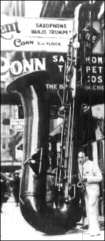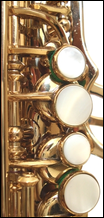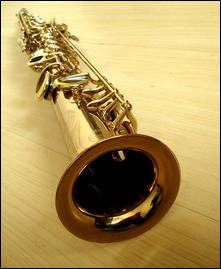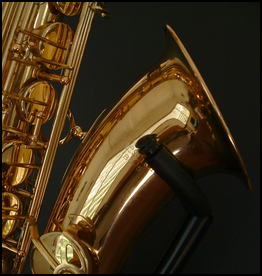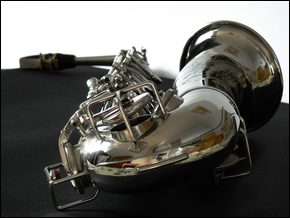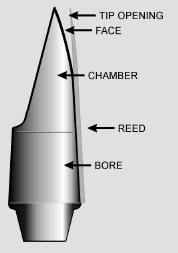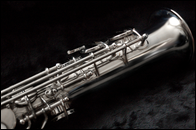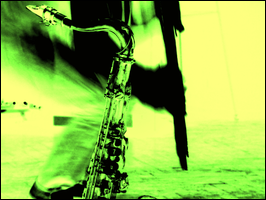Quick Links
sax'o-phone
Blow your own horn — always keeping an eye on the exits...
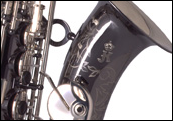
Not just anyone can play sax. First, you'll have to actually buy one. Having done so, you'll need to correctly determine which end to blow into. Then you'll need to fit your dog with NRR 28 or better hearing protection devices. You might also find you need to shop for a replacement family after a few weeks.
sax-o-phone (sak'sa fon') n. a musical wind instrument consisting of a conical, usually brass tube with keys or valves and a mouthpiece with one reed. [sax (see SAXHORN) + o + phone]
Right, so the people who compile dictionaries aren't brass players for the most part. One can't help but suspect that whoever wrote the foregoing entry was thinking of a tunable ear trumpet.
The saxophone is a remarkable instrument unless you share accommodations with someone who's attempting to learn how to play one, in which case it's a bit of a nuisance. Loud, expressive, loud, versatile, loud, evocative, loud, difficult to ignore and loud, it's the horn of the gods if the gods know what's good for them. It's widely believed that the lowest register saxophones are capable of killing chickens if played in close proximity to them, a somewhat apocryphal assertion I've never had the opportunity to verify.

The saxophone is unique in that it's the only popular acoustic instrument known to have been invented by a specific individual — no prizes if you've guessed his name to have been Sax. The variety of available saxophones and reeds make it suitable for numerous musical forms, including jazz, rock, middle of the road elevator music and various ostensibly classical forms. I play jazz and early music — renaissance and medieval works — on sax. If "rap music" were not an inherent contradiction in terms, it could probably be played on sax as well.
Country and western is also not played on saxophone as a rule, as one cannot operate the mouthpiece and spit chewing tobacco simultaneously.
Unlike guitars, which pretty much everyone has attempted to play in some early epoch of their youth, saxophones are not widely found in western households unless someone has deliberately installed one therein. Sort of expensive, potentially embarrassing and not for the faint of heart, the saxophone is an acquired taste. It's best to acquire one with some foreknowledge of the depth of the pit into which you're descending.
This article is an introduction to playing the saxophone. It will prepare you to buy one that's suitable for playing, rather than simply fashioning into an attractive table lamp. It will also get you up to speed with the various saxophone accessories — mouthpieces, neck straps, ligatures, reeds, reeds that taste like bubble gum and so on — which make playing a saxophone so much more complex than playing an iPod.
At the very least, you'll be able to look a music store salesperson in the eye without blinking, or experiencing the uncomfortable suspicion that you're having your leg pulled.
I should point out that this article is an introduction to playing the saxophone for grownups. Kids playing horns is an entirely different subject, and one which I'm singularly unqualified to address.
Finally, to keep the lawyers happy, please note that all the information in this article is provided to you entirely at your risk. In reading it, you specifically absolve its author, Alchemy Mindworks, its shareholders and its suppliers of any responsibility for loss, damage or expense caused by your use of it, however it occurs, including but not exclusive to attorneys' fees. I have no idea how a discussion of playing saxophone can cause anyone loss, damage or expense — in the event that you discover a way for this to happen, you're on your own. Should you be unable to agree to these terms, click on BACK now.
THE OBLIGATORY HISTORICAL OVERVIEW

The saxophone was invented by Adolphe Sax. Adolphe Sax was born in 1814 in Dinant, Belgium. He frequently appears on lists of famous Belgians, so much so that Belgium once released a postage stamp bearing his likeness. In some circles, his is the only name on lists of famous Belgians. The Belgians who maintain such lists usually choose to ignore the observation that their most noteworthy countryman didn't actually become a household name until some time after he'd split for Paris in 1841.
Adophe Sax, like his father Charles Joseph Sax, was a career instrument maker. He'd patented several innovations upon traditional wind instruments by the age of twenty. His first successful instrument, the Saxhorn, was released shortly after he'd relocated to France. It wasn't an entirely new creation, being essentially a bugle with valves. Saxhorns are still played as band instruments in some quarters, and used as plant stands in others.
Sax created the saxophone around 1846. He spent the rest of his life teaching at the Paris Conservatoire — among other things, providing instruction in playing sax. He died in 1894.
Actually, he experienced a few inconsequential financial ripples — the odd bankruptcy, exile to London, screaming creditors and such, and he died largely penniless after spending much of his later life defending his patents — but let us not dwell upon such things. His creation is still played a century and a half later, and not infrequently nailed to the walls of trendy coffee houses by aging beatniks who sell espresso for sixteen dollars a cup. Not a lot of instrument makers can make the same claim, and still fewer employees of the Belgian post office.
A contemporary of Adolphe Sax, Louis Hector Berlioz, the French composer responsible for Symphonie Fantastique and Grande Messe des Morts — the latter admittedly a pretty depressing requiem that could drive clowns to thoughts of suicide — said of the saxophone: "Its principal merit in my view is the varied beauty of its accent, sometimes serious, sometimes calm, sometimes impassioned, dreamy or melancholic, or vague, like the weakened echo of an echo, like the indistinct plaintiff moans of the breeze in the woods and, even better, like the mysterious vibrations of a bell, long after it has been struck; there does not exist another musical instrument that I know of that possesses this strange resonance, which is situated at the edge of silence." Clearly, he hadn't been required to share a flat with somebody learning to play one.
PLAYING THE SAXOPHONE: QUICK START
A saxophone consists of a wide bit at one end that you don't blow into, a narrow bit at the other end that you do blow into and some keys in between that open and close to change the pitch of the notes it plays. The aforementioned narrow bit accepts a mouthpiece which holds a reed. The vibrating reed makes the classic saxophone sound, and after a while it will numb your lips, a decided advantage if you have to do three sets a night.
To play a saxophone, then, blow through the reed and push down on the keys. You're probably wondering what all the fuss was about.
In more practical terms, learning to play a saxophone involves two important elements, to wit:
- Learning to work the reed.
- Learning how to finger the instrument.
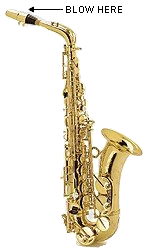
Neither of these is particularly easy, and taken together, they're a bit of a bitch. Unfortunately, you'll need to address them simultaneously. This article will get back to them in somewhat more detail presently.
While you'll probably want a proper instruction book to get started playing sax, or perhaps even formal lessons, it's arguably worth getting into the sorts of things that occupy the initial pages of saxophone books. Before you can begin to play a sax — and before you want to go toe to toe with a musical instrument salesperson — you'll do well to get some of the technology by the throat.
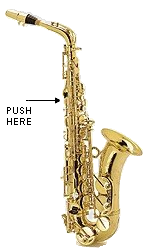
Most of this stuff will be discussed in somewhat more detail later.
The bit of the sax that you blow into is called the "mouthpiece," for reasons which probably require no further explanation. Saxophone mouthpieces are typically made of hard rubber or metal — or of cheap styrene plastic if you insist on using the one that came with your instrument. You can choose a mouthpiece which suits the sort of music you want to play on your saxophone — or at least, you can try.
The noisy part of a saxophone is the reed. A saxophone reed is a sliver of cane cut to cover the opening of a mouthpiece. The reed is clamped between the lower lip of a sax player and the mouthpiece. Reeds are available in a bewildering variety of hardness levels and cuts. We'll deal with them in a while.
I should note that there really are sax reeds available flavored to taste like bubble gum... no foolin'
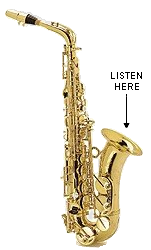
A saxophone reed is prevented from escaping the mouthpiece to which it's affixed by clamping it in place with a band of metal or rubberize fabric called a "ligature." You'll probably imagine so simple a mechanism to require no great esoteric knowledge or significant variation. You'll probably also imagine that pigs can fly, and rocks weighing less than eleven pounds fall upward on alternate Tuesdays during months with an R in them. There is no detail of the design of a saxophone that's so insignificant as to be beyond some myopic engineer in Indiana to tinker into complexity.
The tube onto which a saxophone mouthpiece fits is properly called the "neck" of the instrument. The narrow end is covered with a layer of cork to hold the mouthpiece. The wide end fits into the body of a saxophone. The cork of a saxophone neck is greased to allow its mouthpiece to slide easily over its cork. Even cork grease is a matter of some import to saxophone players — it comes in various flavors.
Saxophones are typically made of brass and coated in lacquer. An instrument which has the appearance of polished brass is said to have a "lacquer finish." Saxophones are also finished in silver, which gives them a somewhat brighter sound. Of late, black lacquer saxes have become popular — a black lacquer finish is said to produce an instrument with a darker tone than a traditional clear lacquer sax, although I suspect they really just produce a higher price tag.

The L.A. Sax company offers saxophones with a variety of other finishes, including various solid colors and animal prints. A zebra saxophone will get you noticed.
Most saxophones are constructed in the traditional J shape. I prefer instruments like this — they look like saxes, and they emit sound such that it's more readily audible to whoever's playing them. They're arguably more comfortable to play.
Saxophones can also be made as straight horns — you might think of these as being a species of metal clarinet. Straight saxes lend themselves to the higher register instruments.
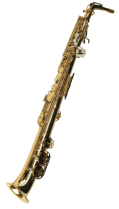
Finally, semi-curved saxes use a straight body and a bent neck. These horns are usually seen in lower-register instruments. A bit exotic, they produce their best sound at the level of a player's feet.
The keys of a saxophone consist of metal disks with leather pads under them to seal the openings in the body of the instrument. When seen for the first time, the mechanism to operate a saxophone can appear breathtakingly complex, and many aspiring saxophone players have merely glimpsed it and run screaming from the room, begging for a few hours of differential calculus instead. In fact, fingering a saxophone is surprisingly intuitive.
The key structure used by a sax is similar to that of a flute, clarinet or oboe — which will, admittedly, only be of assistance if you've formerly played a flute, clarinet or oboe. It's called a Boehm mechanism, invented by one Theobald Boehm, a German instrument maker and a contemporary of Adolphe Sax. While initially scary, it's pretty quick to master if you keep in mind that about half the keys on a sax are rarely used.
Wait 'til you see some of these puppies.
The saxophone is a non-orchestral instrument. This means that it is not highly regarded by classical musicians — guys who live in one-bedroom basement apartments and own ten-thousand dollar fiddles. More to the point, it means that saxes don't naturally play in the key of C.
Saxophones are used extensively in popular orchestras — the conductors thereof just make sure to seat them well away from the violinists, so they don't squabble.
An orchestral instrument, such as the common C flute, does what it says on the box. If you finger a C flute to play C, the note it will play will be C. If you play from sheet music along with other C instruments — a piano, for example — the result should sound reasonably musical, allowing only that all the players involved have the same sheet music.
If you finger a B-flat saxophone to play C, the note it will play will be B-flat. Yes, you do have to wonder who thought this was a good idea — it's sufficient to appreciate that it's the way these things work, and we're all stuck with it.
This isn't as much of an issue as you might think. If you play sax along with other non-orchestral instruments, such as a B-flat trumpet, no one will play C as C. String players can transpose pretty readily. The C flute is so much quieter than a saxophone as to be entirely drowned out by one, making the disparity of keys something of an academic issue at worst.
The most commonly encountered saxophones are as follows. Note that these illustrations are not to scale.

Alto (E-flat): This is the middle of the range of saxophones. It's arguably the easiest of the saxes to play, and has a somewhat lyrical quality. At least, that's what saxophone manufacturers are wont to say of it — I've never been entirely sure what a "lyrical quality" sounds like when it's produced by an instrument that can't sing. Alto horns are comfortable to hold, relatively easy to blow and priced about as reasonably as something as complicated as a sax is likely to get.

Tenor (B-flat): This is probably the most commonly encountered saxophone. It plays a fifth below the alto. This is the sax usually played by jazz and rock performers — typically fairly old jazz and rock performers, as the younger ones mostly play computers. It takes substantial lung power to get one of these things wailing. If you're new to the whole sax thing, it's worth noting that you can differentiate between alto and tenor saxes by the shapes of their respective necks. An alto sax has an L-shaped neck with a slight bend. A tenor sax neck has a distinctive hump in it. A tenor horn is also a lot larger.

Soprano (B-flat): The soprano sax plays an octave above the tenor sax. It's a relatively small horn. Adolphe Sax's original soprano saxes were straight, as are most contemporary sopranos. Curved sopranos do exist, and I find them to sound more like a saxophone than their straight cousins. Soprano saxes are twitchy and difficult to play well. If you play one, your friends will invariably insist on making jokes about your horn having ties to organized crime.

Baritone: (E-flat): The baritone sax plays an octave below the alto saxophone. It's a big mother, and not to be taken lightly. It requires a serious effort to blow, and pretty substantial neck and shoulder muscles to keep aloft. It's a bass instrument, playing in a range comparable to a bass guitar. It's still larger than a tenor sax, with a neck that bends into a loop.
There are three additional saxophones, which you're unlikely ever to encounter. They're useful for mentioning at parties if you find yourself in a crowd of people discussing the esoteric variations of four-barrel carburetors and you'd like something at least as impractical to talk about.

Sopranino (E-flat): Sounding like an enraged hamster, the sopranino saxophone plays an octave above the alto sax. It's a tiny horn, but costing a couple of grand for a reasonable one, it's unlikely to be mistaken for a toy. Sopranino saxes are available in both straight and curved designs. There are almost certainly a few strange pieces of music written for this instrument somewhere, but for practical purposes it doesn't enjoy much of a place in mainstream performance. It probably drives small dogs absolutely insane.

Bass (B-flat): Some bass saxes are so large and heavy as to require a wheeled base with a hydraulic height adjustment cylinder — attempting to support one of these things with a neck strap would probably require a month of traction at the end of your set. Daily practice blowing up truck tires will be of no small assistance in learning to play one of these instruments. There are portable bass horns — the Selmer Model 56, for example — but you'll almost certainly want to press weights for a few weeks before you undertake to play one on a regular basis.

Contrabass (E-flat): The contrabass sax usually lives on a hydraulically-actuated wheeled base — somewhat portable contrabass horns do exist. It's a little over six feet high. It's probably illegal in California, as it plays in a range likely to confuse seismographs. The L.A. Sax web page — the only saxophone supplier I could find which offers one of these monsters — includes an on-line mortgage calculator. Their contrabass saxophone costs $37,500 (US) as of this writing. I have no idea what anyone would want a contrabass sax for, except perhaps to prove that its owner has the disposable income to pay for it or the chest muscles to play it.
THE LEGEND OF THE C MELODY SAXOPHONE
Most saxophone players who find themselves performing with orchestral instruments will eventually wonder how it is that no one's created a saxophone that plays in C, as such an instrument would be something of a convenience. In fact, someone did, a very long time ago. They just don't make them anymore. At least, they almost never do...
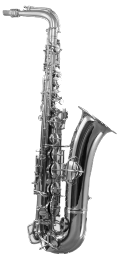
The C melody saxophone is a curious little mutant that appeared in the United States during the 1920s and 1930s. At the time, the great depression saw a lot of people entertaining themselves by gathering around the family piano and singing together. A number of instrument makers created a sax that played in C, allowing it to play along with piano music without transposition.
In time, people found better things to do with their free time — fighting the second world war, for example — and C saxophones fell out of favor. You can still come upon a few of them in hock shops and stores specializing in brass instruments. However, many of them were economical horns to begin with, and age typically hasn't been kind to them. They're impossible to get parts for. After well over a half century of being knocked about, some of these saxes look like hell.
I play a Conn C melody sax that was impeccably restored, and is effectively a brand new horn that was built in 1923. This was a professional instrument to begin with, and having seen new pads, new lacquer and careful adjustment, it plays like a contemporary saxophone. A few of the keys are in unusual places. There are actually several sources of modern mouthpieces for C melody sax — they're made by Runyon, Beechler and J.J. Babbitt, among others. It doesn't project quite as well as my Keilwerths, but in that it's only ever asked to project into a microphone six inches from its bell, this isn't really an issue.
While despaired of by many serious sax players, C melody saxophones are handy if you need to play with other instruments that naturally tune to C. Even the nicely restored ones aren't unbearably expensive.
Several years after this article was originally written, Aquilasax, a previously unheard-of horn builder in New Zealand, began building new C Melody saxophones. Some of their early efforts suffered from design and manufacturing issues, but as of this writing, they make seriously cool saxophones for surprisingly reasonable prices. What's more, for the first time since bathtub gin was fashionable, these instruments play in C. There's a more detailed review of one of them at Storm Gods.
How many C melody saxophone players can you fit in a phone booth? All of them.
CHOOSING A HORN
Buying a saxophone is a very personal experience, and it should never be undertaken lightly... or on line.
In choosing a sax, you should keep in mind that you'll not only be looking for a good horn — you'll be trying to find one that suits you and the music you'll be playing on it. I'll discuss my saxes in a while. They're excellent instruments for the kind of music I play. This is not to say they'd be ideally suited to you.
Saxophone manufacturers like to divide their works into two broad groups, to wit, "student" instruments and "professional" instruments. These categories are a bit fuzzy, with a substantial gray area between them. As a rule, student horns are machine made — usually in places like Taiwan and Korea — and probably don't make Adolphe Sax want to rise from his eternal slumber to blow a few notes on them. Professional horns are usually hand made — the more prestigious instruments hail from France, Germany and Japan.
Student instruments are to some extent a misnomer — which is to say that students might not be the ideal people to play them.
A saxophone is a very complex work of engineering and manufacturing. Before the instrument makers start cutting brass, someone with a great deal of understanding of acoustic physics has to design the beast. A lot of research and development goes into really good horns. Needless to say, this reflects in their prices.
Building them isn't easy either.
Low-end saxes typically embody a number of important limitations:
They don't sound all that good. This can be a bit tricky to pin down, especially if you're fairly new to the instrument. Someone who plays sax — the salesperson trying to sell you one, for example — can often make a cheap horn sing. That's not to say that you'll be able to do so as readily.
They're not particularly easy to play. The complex mechanism of a saxophone requires a degree of craftsmanship to make it behave, and horns that are slapped together by robots usually don't quite get there.
They don't last all that well. The really hard steel bearings and high quality leathers of a professional horn will stick around a lot longer than the more economical components usually found in student horns. Low-priced instruments typically require more frequent trips to a repair shop, all other things being equal.
They're not consistent. Less well-built instruments are often affected by temperature and humidity. They usually don't enjoy the tightest intonation, which means that some notes might not play right in tune — not that saxophones do this all that well at the best of times.
They don't look as nice, nor do they stay looking reasonable as long. A saxophone is also a visual experience — playing a horn that looks like it used to be a soup tin isn't as enjoyable as playing one that really shines.
In the event that you're just getting started with a saxophone, you'll be clamping your lips around a really intimidating, complicated machine. Your first attempts to play it will almost certainly sound like an elephant with some sort of respiratory condition. If your lips are clamped around a low-end horn with a three-digit price tag, you'll spend a lot of time wondering if the difference between what you're playing and what you wish you were playing is the result of your as yet undeveloped ability... or the limitations of your horn.
If you're serious about playing saxophone, buy a serious saxophone to start with. Spending four or five grand on an instrument is a large and unsettling first step. However, consider how motivated doing so will make you feel. Blow a month's pay on a horn and you'll learn to play it if it kills you.
Once again, I should note that this is a somewhat grown-up perspective. Kids are often brutal toward brass instruments — giving your child a four-thousand dollar saxophone could prove traumatic.
As an aside, if you are confronted with a child who wants to play horn — and you're reasonably certain you can withstand the obligatory practice sessions thereof — you might want to be wary of the dark and turgid issue of profoundly cheap horns from the mall.
Several big box retail stores offer very inexpensive wind instruments — a shiny, apparently authentic tenor sax can be had for about three hundred dollars. Parents appear to buy these things for their kids because they're a lot cheaper than even the most affordable student instruments at dedicated music stores. I suspect that they regard an entry-level sax as an inexpensive introduction to playing horn. If the kid doesn't prove to have the ability to play it, they won't be out well over a grand for a serious instrument.
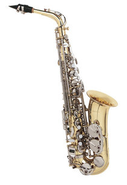
It's a safe bet that if you buy your child a cheap sax from China, your child will unquestionably prove to lack the ability to play it. My friend Jon, who'll turn up again at the very end of this article, manages a serious musical instrument shop. He refers to these things as ISOs — for Instrument Shaped Objects. No one can play them well, and after a few weeks, it's usually the case that no one can play them at all. Most serious horn repair technicians won't get within a furlong of one once it starts dropping springs, either — they're essentially irreparable.
Getting started playing a sax will be infinitely more difficult if your kid is battling an instrument that was banged together in a disused auto-parts factory in Beijing. While you might not ultimately be able to afford the saxophones to be discussed herein — which, if the truth be told, are brutally expensive little beasts — you'll make your child's brain a happier place to live in if you shop for a horn at a real music store. Most of the high-end instrument builders to be mentioned herein offer student instruments as well. There's a Taiwanese sax builder called Jupiter that makes singularly good student saxes at singularly reasonable prices.
Jupiter's saxes still cost several times what the big box store instruments go for, but they have the advantage that you can actually play them, rather than being limited to using them as designer umbrella stands.
SAXOPHONE MANUFACTURERS
Considering how specialized saxophones are, it's surprising how many sax makers exist. I wish I had the time to try them all.
My list of saxophone manufacturers is decidedly incomplete — it reflects my taste in horns, and those which I've had the opportunity to play. If the instrument you're considering doesn't appear below, the music shops out here probably just don't sell them.

Keilwerth: Keilwerth is one of the more select builders of professional horns. They're located in Nauheim, Germany, near Frankfurt. Most of my present alto and tenor saxes were built by Keilwerth — they're among the nicest instruments I've played. Keilwerth's horns have a somewhat darker, more textured sound than is common for sax.
Keilwerth's high-end saxophones are available in several models as I write this. The EX90 horns are described as "semi-professional" and the SX90 instruments are their high-end professional saxes. The distinctions between them are somewhat esoteric. The SX90s offer adjustable palm keys, real mother of pearl buttons and perhaps most notably, aluminum road cases that seem capable of withstanding the attentions of an irritated rhinoceros. The EX90s come in a conventional wooden hard-shell case, have imitation mother of pearl buttons and you'll have to live with the palm keys as they come from the factory. I have one of each — I've never actually adjusted the palm keys on my SX90.
My favorite horn on earth is a Keilwerth Shadow alto sax. Made of nickle silver, rather than brass, it's dark, brooding and intricate. It's also the most responsive instrument I've ever owned, and a peach to play. There's a more extensive view of it at Storm Gods.

L.A. Sax: I know these horns by reputation only — I've heard encouraging things about them, but I've not had the opportunity to play them. Beyond how they sound, however, L.A. Sax instruments offer the most interesting selection of finishes. You can order them with traditional clear lacquer, a number of solid colors — and reproductions of several animal hides, including snow leopard, Grevy's zebra and Siberian tiger. They also do one called Tequila — words hardly do it justice.

Selmer: Selmer's high end horns are the embodiment of French saxophones. They're bright, jazzy and fast. I play a Selmer Series III alto that's a force of nature. It projects its sound like an industrial laser, and could probably cut through the noise of a 747 taking off. It has fantastic presence, for situations wherein subtlety is clearly uncalled-for.

Yamaha: One of the horn manufacturers you're more likely to encounter, Yamaha builds a range of student and professional saxophones. The manufacturing standards of their high end instruments are impeccable. I've yet to encounter a Yamaha horn that seemed wholly appropriate for the music I play on sax. This is unquestionably subjective, however — Yamaha's instruments are well regarded in some circles.

Yanagisawa: My soprano sax was made by Yanagisawa. It's beautifully crafted, and lacks the nasal quality that often inflicts soprano horns. It has a light, solid feel to it, and flawless workmanship. Yanagisawa builds a complete range of saxes, but perhaps most notable is their SC-901 curved soprano. There aren't many sax manufacturers who build professional curved sopranos, and this is easily the finest of them I've tried. It cost a fortune and took forever to get here — if I hadn't spent it on a horn, it probably would have just gotten squandered on groceries.
BUYING A USED SAXOPHONE
You probably shouldn't.
Getting started playing sax is a fairly daunting prospect. In addition to learning to manage a reed, learning how to finger the instrument and perhaps trying to remember how to sight-read music, you probably don't need to deal with a potentially funky horn. Saxophones, as I've noted earlier, are complex machines, and they have a wealth of things that can go wrong with them.
Most of the potential problems with a sax grow more prevalent with age. After a few decades of serious playing, a saxophone will typically suffer from pad wear, a need for lubrication, a few rods and bearings that require adjustment, a worn or damaged neck cork and perhaps enough dents and deformities to affect its sound.
Knowing whether a used sax is playable in a meaningful sense — or how much it will cost to get it back up to speed — involves knowing a fair bit about saxophones. It's beyond the scope of this discussion to deal with the dark, treacherous little secrets of saxophone repair, save to say that people who are really knowledgeable in this area get paid the big bucks for a reason. If you knew enough to evaluate a used horn, you wouldn't be reading this article.
If you hang around with other horn players for a while — and you don't mind listening to more questionable tales than would seem reasonable — you'll undoubtedly come across someone with a five grand cherry sax that was discovered at the back of a junk shop for twenty dollars. This is not a good reason to shop for instruments in junk shops — rather, it's why you shouldn't believe what other musicians tell you about their instruments.
Anyone with a sax to sell and an internet connection can easily determine what their instrument should sell for, and you'll encounter few horns priced well below what they're worth. If you come upon a used saxophone for twenty dollars, its owner has probably determined that it won't fetch much more.
Shopping for a used horn — ill-advised though it may be — will lead you to one of the following sources.
Instrument Shops: Brass instrument dealers usually sell used horns as well as new ones. They often acquire old saxes as trade-ins for new instruments.
Most professional horn shops that sell used instruments do so after having reconditioned them. A reconditioned sax will have had its pads checked and replaced as needed, its rods adjusted and bearings lubricated, its more serious dents fixed and so on. It would be unwise to expect a reconditioned horn to play quite as well as a new one, but a competent repair person can do a lot with an old sax.
You'll no doubt be wondering how to ascertain whether that instrument shop down the road employs a competent repair person, or just a kid in the back with a tin of Brasso and some Three-In-One oil. Once again, you'd need to know a lot about saxophones to determine this.
Many musicians who trade in old saxes to buy new ones do so to step up from student horns to professional instruments. As such, a lot of the reconditioned saxes available started life as fairly low-end brass — twenty years of playing followed by a new set of pads and some dent removal won't have improved their attitudes.
You'll also find a few high-end saxophones that have been reconditioned. Some of these can approach the sound and feel of new horns. Unfortunately, they typically don't cost a lot less than new horns, making the prospect of buying a used instrument somewhat questionable.
Don't confuse a horn which has been polished up to look pretty with one that's been professionally reconditioned to sound good.
It's also worth keeping in mind that contemporary saxophone manufacturers have access to metallurgy and technology that didn't exist a few decades ago, and modern saxes just play better than their ancestors of ages past.
As an aside, you'll probably want to avoid guitar shops with an ancient, dusty saxophone in a cracked glass case at the back of the building, partially obscured by a stack of rental amplifiers. If you're seriously considering a used horn, buy one from a shop that deals primarily in brass instruments.
Private Sales: Buying a saxophone from someone you'll never see again and have no good reason to trust is only slightly more intelligent than believing what liberal politicians say before an election. This is not to say that all the saxophones available for sale by private individuals are in bad shape — once again, however, you'd need to know a lot about saxes to evaluate them.
The cost of dragging a tired old horn back to life can well exceed what you'll save buying it used to begin with.
e-Bay: Something of a global junk shop, e-Bay is not the place to buy things you don't know a lot about. As with private sales, some of the instruments available on e-Bay are in great shape and can be had for truly competitive prices, but you'll have even less chance to evaluate the horn of your dreams on line than you would if you were buying it from a private seller.
Shopping for a used horn can be a lot less of a crap shoot if you do so with the assistance of a third party who plays sax. Alternately, buying one from a music shop you've done business with before and you feel you can trust is desirable. Absent both of the above, I'd only suggest it if you have a lot of money you don't like the look of, and some time to kill.
As an aside — another one — saxophones have serial numbers, and many sax manufacturers can ascertain the age of an instrument based on its serial number. If you visit the web page of the company that built the used sax you're considering, you'll probably find an on-line serial number decoder to tell you when your prospective horn was built.
VINTAGE SAXOPHONES
Vintage saxophones are used horns that were used a long time ago. While the term is frequently misapplied to anything brass with a lot of dents and scratches, it really speaks to professional instruments with half a century or more on their clocks.
In some circles, saxes with a lot of history are highly prized — consider them to be the immaculately-restored 1954 MGs of horns. Unlike half-century-old English sports cars, however, saxophones don't deteriorate markedly with the passing of decades. Many of them outlive their original owners, and a few generations of their original owners' descendants as well.
The most desirable vintage saxes are those with a lot of ornamentation — the engraving on some old horns is breathtaking. They usually have real mother of pearl keys, and often gold inlay. The style of some of these instruments is usually more ornate — or decidedly flamboyant — than their contemporary offspring.
Some players claim that old horns, having been singing for longer than most of the people who currently own them have been alive, just know more tricks and speak with more soul... if you believe in that sort of thing.
Returning to planet Earth for a moment, there are a number of serious drawbacks to buying a vintage saxophone, especially if it will be your first instrument:
They're expensive: For a long time, you couldn't give these things away. At the moment they're trendy as hell, and they come with price tags to match their celebrity. Vintage horns often cost more than comparable new instruments.
Not all old horns are good horns: Even the really legendary saxophone manufacturers have been responsible for some serious turkeys. It's not uncommon to encounter attractive vintage instruments that sound stuffy, or squeaky, or which have dreadful intonation. Be slightly wary of old horns that appear to be in unusually good shape — if the first person who owned it hardly ever played it, there might have been a good reason.
They're hard to get parts for: Needless to say, you can't just order replacement keys and rods for a fifty year old saxophone from the company that originally made it, even allowing that the company that made it still exists. Keeping an old horn playing can be an expensive — and on-going — undertaking.
They don't always sound as good as they look: Saxophones are not Stradivarius violins — there are no lost secrets of the old horn builders. Modern sax manufacturers typically don't engrave reclining nudes into the bells of their instruments, but high-end contemporary instruments can sound every bit as good as their ancestors. With better metallurgy and manufacturing techniques, and a vastly superior understanding of acoustic physics, modern sax builders are able to exercise a much more precise control over the instruments they build — modern horns offer a wider range of sounds.
They're not always particularly easy to play: Horn builders working during the first half of the twentieth century couldn't design and build key mechanisms with the precision of modern instruments, and they didn't have access to the range of metals presently available. Vintage saxes can require somewhat more work to move their keys.
Some of them are a bit weird: While it was invented by a single instrument builder, the saxophone as it exists today embodies the refinements and tinkering of dozens of forgotten engineers. Adolphe Sax's original horns lack a number of the keys available on modern instruments. Some old horns predate the acceptance of these additional keys, and as such are unable to play specific notes. Some have unusual arrangements of keys — evolutionary "dead ends" in the history of sax design which must have seemed like a good idea at the time.
As with buying a used saxophone, it takes a veteran horn player or a good repair person to realistically evaluate a vintage sax. If you're just getting into playing saxophone, you probably don't need the peculiarities of a cranky old instrument to add to the issues you have to deal with.
It's also worth noting that vintage horns get less playable the further back in time you get. Saxophones built prior to the 1930s typically have sufficiently erratic intonation and unconventional fingering as to be useful only as innovative plumbing fixtures and duck calls.
Collecting vintage saxophones can be an engaging pastime if you have several platinum credit cards and you're into this sort of thing — it's just not the shortest path to learning to play a horn.
CHOOSING A RANGE
It's unlikely that you'll want to begin playing the contrabass saxophone, even if you can afford one. The common ranges of sax — soprano, alto and tenor — are the best instruments to get started with.
Your choice of a horn will be determined to some extent by what you want to play on it, and who else you envision playing it with. This assumes that you still have any friends left after it becomes known that you own one of these things.

Alto: If you want to start playing saxophone and you have no other conditions in mind — such as getting along with additional instruments — an alto saxophone is arguably the easiest place to start. The horn itself is of a manageable size. Its reed is not so large as to require a regimen of breathing exercises to be able to work it, and not so small as to be twitchy and difficult to control. Alto saxophones are reasonably common, and widely available. The potential drawback to an alto sax is that it's an E-flat instrument, making it less than optimally convenient if you want to play with, for example, a B-flat trumpet. This isn't a real deal-breaker — everyone should learn to transpose between two inconvenient keys. It's character-building.

Tenor: A tenor saxophone is larger and heavier than an alto, and nearly impossible to play sitting down unless you provide yourself with a bar stool. The larger reeds used by tenor saxophones require more lung power to play, but they're even more forgiving than those of an alto saxophone. It will also take you longer to condition your lip muscles to properly compress a tenor sax reed, all other things being equal. Lip muscles and other squishy biological issues will be addressed later in this article.
Tenor saxophones play in B-flat, a key more likely to get along with other brass instruments — a worthwhile consideration if you plan to play with other horns.
Starting from scratch with a tenor saxophone will be slightly more difficult than learning to play an alto horn.

Soprano: A soprano saxophone has a relatively small reed. It requires very little breath to make it noisy, but a substantial degree of control to keep it from squeaking and laughing and generally sounding like a room full of teenage girls doing tequila shots. Learning to make a soprano sax reed behave itself is a considerable undertaking.
Having said this, the small size of a soprano horn makes it a comfortable instrument to get used to. There's not a lot of call for soprano saxophones in most of the places saxes turn up — it's a nice lead instrument in jazz. Being a B-flat horn, sopranos work well with other common B-flat wind instruments.
All of the foregoing aside, if you're particularly disposed to one of the foregoing horns — even if for no other reason than you like the look of it — you should definitely ignore these considerations and go for it.
REEDS
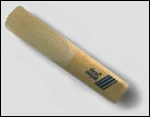
Reeds are the most contentious aspect of playing a saxophone. Unlike a saxophone itself — a precision-engineered machine crafted of metal — reeds are natural, organic objects which start out growing in a cane field. No two are exactly alike, and for practical purposes, they rarely even seem to get close.
This is something of a nuisance, as having consistent reeds which all exhibit the same tonal qualities goes a long way toward making one's saxophone playable.
Saxophone reeds are available in a truly frightening variety of cuts, styles, shapes, filings, sandings, tonalities, hardness levels and tastes. Each range of saxophone has its own reed. Reeds range from incredibly cheap and borderline-unplayable machine-made student abominations right up to hand-cut reeds that probably belong in an art gallery.
Finding a reed that suits your saxophone, your level of playing ability and the kind of music you'd like to play can be a bit daunting. It will help if you understand something about how reeds work. In addition, be sure to check out which brands and styles of reeds the music shops in your area stock. There's not a lot of point in deciding that you prefer Concert Grand Select reeds, for example, if you can't actually get any.
Sax reeds are made from cane, which in most cases is grown especially to make instrument reeds. Cane is actually a species of grass. It takes about two years to grow cane to the size and density required to cut professional-quality instrument reeds. After it's cut, it's dried for an additional two years.
Saxophone reeds are available in several levels of hardness, numbered from one through five. Number one reeds are the softest. Most reed manufacturers offer reeds in increments of one half step of hardness.
If you're new to playing saxophone, you'll probably want to start with a number two reed for alto or soprano sax, and a number 2½ reed for tenor sax. As will be discussed later in this article, a crucial aspect of learning to play sax is working up your lip muscles to properly control a reed. Softer reeds require less lip muscle, a worthwhile consideration when you're still trying to prevent your horn from frightening your dog.
It's important to keep in mind that the ultimate hardness of the reeds you choose is not indicative of your level of playing ability. Once you get your instrument to behave, you'll be able to select a hardness level of reeds based on the sound you want to create.
All other things being equal, softer reeds produce a darker, more classical sound, while harder reeds produce a brighter, jazzier sound. If you select a reed that's too soft for your horn, it will sound raspy and generally unpleasant. Harder reeds require more lung power to play.
I play number 2½ reeds for soprano and alto sax, and number three or 3½ reeds for tenor sax. Keep in mind that I play cool jazz, and early and baroque music, for the most part, not mainstream jazz — your choice of reeds probably won't be quite the same.
The two most commonly-encountered brands of saxophone reeds are Vandoren, which are made in Provence, France, and Rico, which hale from California. Both manufacturers make a range of reeds for different horns and different playing styles.
I prefer the sound of Vandoren's reeds for the music I play — once again, this is entirely subjective, and you should decide which reeds best suit what you like to play. Vandoren reeds cost a bit more than Rico reeds — at least, they do where I live.
Both reed makers offer several styles of reeds.
Rico Reeds
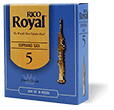
Rico: Rico orange box reeds are economical and not half bad. They're intended for students, who may get through rather a lot of them. I've used them in a pinch for more serious pursuits.
Rico Royal: One step up from Rico standard reeds, Rico Royals are comparable to Vandoren Traditional reeds. They're French filed — additional bark is removed from the thick part of the reed to make them more flexible. I find them to be a little brighter than I'd like them, but this has to do with what I usually play on sax.
Rico Select Jazz: A reed cut specifically to play jazz, Rico Select Jazz is a brighter, faster reed. It's available with or without French filing. Notice how the permutations of these things are beginning to get complicated.
Rico La Voz: La Voz is a premium reed, cut more in the manner of Rico Royal reeds. It's unfiled, for a somewhat fuller, less jazzy sound.
Frederick L. Hemke: Hemke reeds are somewhere between classical and jazz reeds. They're French filed and they have a fairly dark tone.
Grand Concert Select: A high-end classical reed, Grand Concert Select offers better than average consistency between reeds, a nice dark tone and somewhat longer life than lesser reeds.
Vandoren Reeds

Traditional: At present, I play Vandoren Traditional reeds, or "blue box" reeds for the most part. These reeds are cut to produce a darker, classical sound. This is a good choice for reeds to get started with, as jazz reeds are somewhat more difficult to control.
JAVA: Vandoren JAVA reeds are cut to produce a brighter sound than Vandoren Traditional reeds. They're more suited for jazz and commercial music.
V16: Vandoren V16 reeds are similar to their JAVA reeds, but with more wood. They're stiffer, with a more percussive sound.
ZZ: Vandoren ZZ reeds are cut to be very bright, offering an extremely jazzy tone. They're real firecrackers, with a quick response and a very hot sound. They take some getting used to, as it's easy to blow them too hard and turn them into duck calls.
Rico also does Plasticover reeds, which are conventional reeds encrusted with a plastic film to keep them playable in adverse conditions — I've never actually tried one, but they sound a bit daunting — and Symmetricut reeds, which are really cheap 'n nasty, and apparently intended for kids. I'd avoid the latter unless they're absolutely the last chicken in the shop.
In my experience, Vandoren Traditional reeds are about half a grade harder than Rico Royal reeds. As such, a Vandoren Traditional 2½ reed is equivalent to a Rico Royal three reed. I haven't played enough of the other reeds discussed here to be able to offer similar comparisons. This is, needless to say, highly subjective.
REED CARE AND USE
Saxophone reeds are ineffable, fragile and more than a bit funky. They have lives of indeterminate length, and they rarely do exactly what's expected of them. They can be a bit frustrating at times.
When you first begin to play a reed, it will typically be slightly harder than it's supposed to be — or at least, slightly harder than it will be once it's been played for a while. Give it half an hour and it should settle down to it's "real" hardness. It will get gradually softer throughout its life. If it doesn't succumb to a number of other ailments and means of destruction, it will eventually soften to the point where it can no longer produce a clean tone, and is suitable only for propping up wobbly furniture.
The actual working life of a reed is a somewhat imponderable value, being dependant upon the qualities of the cane it was cut from, the chemistry of the saliva of whoever plays it — yes, this is a bit gross — how it's played, and how particular its player is. Some of them hang on for months, and some are toothpicks an hour after they're unwrapped.
The degree of strength of your lip muscles require to play a reed will diminish with the actual hardness of the reed in question. In effect, playing a soft reed will allow your lips to slack off and grow weaker, not a desirable characteristics for lips that want to play sax. Inasmuch as no two reeds soften at the same rate, you should actually keep a number of reeds going at once, alternating between them so your lips aren't dealing with the same one every time you play.
One of the most sought-after — and elusive — qualities of commercial saxophone reeds is consistency. Ideally, every reed you play should exhibit more or less the same tone and level of hardness, such that your playing will have the same timbre and style no matter which reed you use. While this is laughably impossible in an absolute sense, you can come pretty close to it by choosing good reeds that suit the music you plan to play on your sax, and managing them carefully.
You can do a lot toward improving the consistency of your sax reeds by storing them in a humidity-controlled environment. This does not require an elaborate environmental chamber with a refrigeration pump and a mainframe computer to monitor its internal barometric pressure. A reed case will suffice. A reed case consists of a more or less air-tight box which contains a desiccator — usually a tube filled with activated charcoal or silica, similar to the moisture absorption packets that are included with electronic equipment and cameras when you first unpack them.
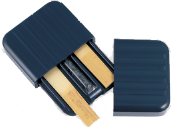
I use Vandoren's reed cases. They hold four reeds and a replaceable dessicator. The slots for the reeds are numbered, making it relatively easy to remember to cycle through them. The dessiator tubes can be dried out by removing them and cooking them under a desk lamp for a few hours.
If you live in an extremely dry climate — such that your reeds actually become too dry if they're left to their own devices — you can replace the dessicator with a damp sponge.
Reeds are heir to a number of fates more treacherous than growing soft and raspy in their old age. The most immediate of these is splitting — they'll occasionally do so on their own, and as they're exceedingly fragile, it's not difficult to advertently assist them in this through mistreatment. A split or chipped reed is dead useless, and should be discarded immediately. To avoid accidentally damaging a saxophone reed, always handle it by its bark — the fat bit that your lips don't come in contact with — and don't touch the tip.
Reeds are also susceptible to warping. A sufficiently warped reed won't make even contact with the edge of the mouthpiece it's clamped to no matter how much lip pressure you apply to it, and will have to be replaced.
Most reeds warp or ripple slightly when they're not being played — this minor warp will flatten itself out as soon as you start playing.
It's not uncommon for new sax players to do minor damage to the insides of their lips, with the result that a small amount of blood may be deposited on your reeds at first, coagulating into black stains. While blood won't affect the sound of your reeds, it will arguably make them too unpleasant to put in your mouth.
Sugar is one of the silent killers of sax reeds. Sugar crystals that come out of solution are large enough and stiff enough to work themselves between the fibers of the cane which comprises a sax reed and affect its hardness. You can extend the life of your reeds considerably by ensuring that your mouth is free of sugar before you begin playing. Sugar-free mouthwash is an excellent saxophone accessory — original Listerine is ideal if you don't mind applying an acid peel to your tongue from time to time.
If you play sax in bars, keep in mind that beer and wine may contain sugar.
The inherent inconsistency of the cane used to make saxophone reeds means that not all the reeds in a box will be identical — actually, it means that not all the reeds in a box will be immediately playable. It's not uncommon to encounter brand new reeds that are too hard or too soft to play the way you'd like them to. If a reed hasn't attained a suitable degree of hardness after you've played it for half an hour, it probably never will.
You can adjust reeds that are too hard by sanding them to make them slightly thinner. Get a sheet of very fine sandpaper and glue it to a flat piece of wood — particle board is ideal, as it doesn't warp. Place your errant reed with the flat side toward the sandpaper and rub it across the abrasive. This takes some experience to do correctly — you'll probably file a few reeds down to shadows of their former selves before you get it right.
You can adjust a reed that's too soft by trimming a sliver of wood from its tip. While the careful application of a very sharp knife — or even fingernail scissors — can accomplish this, you'll achieve much better results with a reed clipper, a hand-operated trimming machine designed for the task. These cost about as much as two boxes of reeds, however. This, too, takes some practice.
In answer to the obvious question, no one has yet devised a useful application for old saxophones reeds. They remain suspended in the shadowy realm of things too worthless to keep and too valuable to throw away.
Inasmuch as reeds are by their nature something you're likely to put in your mouth, you should take reasonable care to ensure that they're clean, and that they stay that way. Before you use a reed for the first time, you should at the very least wash it in warm water for fifteen or twenty seconds. I prepare new reeds by soaking a Kleenex in isopropyl alcohol and swabbing the reeds with it, then washing them. I confess to having no idea if this level of precaution is necessary in using commercial reeds — the alcohol's cheap.
You should also clean your reed case once every two to four weeks with alcohol or other disinfectant, and any current reeds you're using. This will help inhibit the growth of bacteria, which might otherwise mutate in the dessicator tube and slime their way out late one night to menace civilization and turn the entire world into a really bad B movie. No foolin'
Should anyone notice you doing this, try to resist the temptation to refer to it as "practicing safe sax."

If you don't like the smell of alcohol, there's an odorless commercial disinfectant available specifically for wind instruments called Sterisol. Note that there's also a brand of mouthwash with more or less the same name — they're not interchangeable.
Prior to playing a reed, you'll need to wet it. Traditionally, this is handled by putting the reed in your mouth for a few minutes, and walking around looking foolish. It's worth noting that doing so can shorten the lives of your reeds if you have particularly acidic saliva. It's said to be preferable to wet them in warm water for a minute or two.
This isn't always convenient, and if you leave them in water too long, they're likely to warp or ripple. I've not noticed much of a hit on reed life by wetting them in the traditional manner — your mileage may vary.
MOUTHPIECES
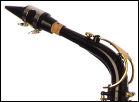
If you felt that choosing a suitable reed for your saxophone was somewhat involved, nothing will have prepared you for the almost demonic complexity of saxophone mouthpieces. I play Selmer C* mouthpieces on my soprano and alto horns, and a Vandoren V20 mouthpiece on my tenor — mostly because I like their sound, and to a lesser extent because I couldn't face the more esoteric alternatives... all one and a half billion of them.
There are innumerable mouthpiece manufacturers, each of them with a variety of styles and designs intended to produce different sounds. Some of the reasoning behind more exotic mouthpiece designs borders on witchcraft. Not all the distinctions between mouthpieces are audible.
Saxophones invariably come with mouthpieces. Most serious horns come with inexpensive plastic mouthpieces, probably under the assumption that a professional horn player will have a favorite mouthpiece, and will be unlikely to use the one that came with his or her new horn. Plastic mouthpieces typically won't bring out the best in the horns they're playing.
A sax mouthpiece has several important functions. It holds the reed, and keeps it from flapping in space like spaghetti in a wind tunnel. It also provides a chamber which modifies the sound of a vibrating reed. Finally, it provides a precise gap between the flat surface of the reed and the material it's resting against, across which the reed can vibrate.
Some serious computer simulation and number crunching goes into designing these things.
The size and shape of a sax mouthpiece will have a pronounced effect on the sound your horn produces, as will the material your mouthpiece is made of. Books have been written about this stuff, and highly impenetrable books they are. This article will merely touch upon the gray-green scaly flesh of the subject.
The chamber behind the reed in a sax mouthpiece is the most determining aspect of its design. A large chamber will tend to emphasize the lower tones generated by the reed — the lower "harmonics," for those who stayed awake during high school physics. A smaller chamber will emphasize the higher tones. As such, large chamber mouthpieces are more suitable for classical music, and small chamber mouthpieces will enhance the brighter aspects of a horn for jazz.
The face of the open portion of the chamber of a mouthpiece which is covered by a reed isn't perfectly flat. It curves away from the reed, to allow the reed room to vibrate. This "tip opening" size also has an effect on the tone produced by a mouthpiece. A large tip opening allows for softer reeds, which in turn produce darker tones. A small tip opening suits harder reeds, and brighter, jazzier tones. You'll find a more detailed discussion of tip openings later in this section.
Most professional saxophone mouthpieces are made of hard rubber or metal. Hard rubber mouthpieces are very dense, and they tend to dampen higher-pitched sounds. They favor a darker, warmer sound, and suit classical performance. Metal mouthpieces are less dense, and enhance higher tones. They favor jazz.
None of the foregoing is immutable — you can play jazz on anything, for example, and not all jazz saxophone has to sound bright and edgy.
Metal mouthpieces are considerably more durable than mouthpieces made of hard rubber — the latter is susceptible to wear, cracking and deterioration. More exotic mouthpieces are available made from several other materials, most notably crystal. I don't think we need go there right now.
Once you get your playing up to speed, you might want to take your horn to a professional brass shop and try out a variety of mouthpieces. Writing about music is like dancing about architecture — a verbal description of what these things sound like isn't one wit as useful as actually playing them.
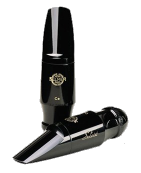
In the mean time, I heartily recommend the Selmer and Vandoren mouthpieces — they're made in versions to suit most styles of music, most horns and most players. They're not available in candy-apple red and they're rarely described as "soaring," "breathtaking" or "rapturous" — but they play well and they'll keep both your reed and your mind from flapping in space like the aforementioned spaghetti in a wind tunnel — perhaps this is all a sax player should expect of a mouthpiece.
As an aside, it's not always obvious to players new to saxophones — or more properly, to the dark and turgid waters of saxophone accessories — whether a black mouthpiece of indeterminate manufacture is made of plastic or the more desirable hard rubber. You can tell by the smell — plastic mouthpieces don't smell at all, and hard rubber mouthpieces smell very faintly of burning tires. As another aside, should you find yourself troubled by the occasional whiff of hot rubber from your mouthpiece — it can lead the absentminded to wonder fleetingly whether they've forgotten something on the stove — you might want to spring for a tube of scented cork grease. I find orange to be the most effective at masking the aroma of a rubber mouthpiece with an attitude. We'll get to cork grease presently.
Tip Openings — More Than You Want to Know: In choosing a mouthpiece, it's worth understanding how tip openings, or "facings," actually affect what you'll play on it. You might regard this as being something of an advanced topic, and one you could arguably skip over if you don't find yourself to be in need of sleep. A light dusting of acoustic physics follows.
The ideal mouthpiece from a wholly acoustic perspective would have a flat facing — the opening where the reed lies against the mouthpiece would not be at all curved. This would result in the only opening in the mouthpiece being where it gets slid over a saxophone neck, and all the sound generated by the reed attached to the mouthpiece in question would wind up in your horn.
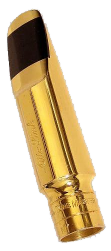
There is one small drawback to such a mouthpiece — it would be effectively unplayable. The curve in the facing of a sax mouthpiece is there to permit its reed to move.
When you blow through a sax reed, it vibrates. If you could slow this activity down a lot, you'd be able to see it flapping back and forth, alternately closer to and further from the facing of your mouthpiece. When it flaps toward the mouthpiece, it moves into the area left available for this very purpose by the curve of the facing.
As it's mechanically impossible to create a mouthpiece that's completely closed at the reed end — inconveniently, quantum physics thus far refuses to permit a reed and a mouthpiece to simultaneously occupy the same physical space — the next best thing is one where the gap between the reed and the facing is as small as possible.
Sound energy squeezes through small spaces more effectively as the pitch of the sound increases. This means that if the gap between the reed and the facing is very small, only high notes — or more properly, high harmonics of notes — will be able to sneak through it, rather than traveling down the neck of your sax, where they can do some good... or some damage, depending on how well you can play your horn.
 All other things being equal, a soft reed vibrates over a larger space than a hard reed. If you could measure the distance the vibrating tip of a reed moves while it's being played, the tip of a soft reed would move further.
All other things being equal, a soft reed vibrates over a larger space than a hard reed. If you could measure the distance the vibrating tip of a reed moves while it's being played, the tip of a soft reed would move further.
When the face of a reed strikes the facing of a mouthpiece, the resulting sound is much more reminiscent of a Chevy Biscayne with a cracked rad hose than a saxophone, and for this reason, it's largely to be avoided. In choosing a mouthpiece, then, you should try to find one with a tip opening that's large enough to permit the reed you plan use to vibrate freely in the tip opening space, but no larger.
Short of hiring some really small guys to crawl inside your mouth with space suits and a micrometer, this will no doubt be a bit difficult to ascertain empirically. You'll probably want to enlist the assistance of a knowledgeable sales person at an instrument shop — ideally, you should choose a mouthpiece by trying several of them on your horn, with your choice of reeds, playing the sorts of tunes you like
As a quick guide:
- Classical and baroque music is usually played with soft reeds, which require a larger tip opening. Soft reeds and large tip openings favor lower tones, and will produce a darker, richer sound.
- Jazz is usually played with hard reeds, which can accommodate smaller tip openings. Hard reeds and small tip openings favor higher tones, and will produce a brighter, more forward sound.
If you're not at least a bit confused by now, you're not trying.

Mouthpiece position: It might not be immediately obvious if you're new to playing sax, but the extent to which you slide your mouthpiece onto the neck of your horn determines how the instrument will be tuned. Slide it further onto the neck to make your saxophone play sharper. You might want to spring for a small chromatic tuner to tune your horn — the Korg CA-30 is a good choice. Failing this, banging on a piano works as well. Once you ascertain where to position the mouthpiece, you can mark your neck cork with a pencil. The mouthpiece position shouldn't change unless you change necks or mouthpieces.
If you position the mouthpiece of a saxophone too far up the neck — that is, if you make the play horn way too flat — it may tend to warble when you play in the bottom half of the lower octave. This can be a bit puzzling if you're just getting started. There are no mice hiding in your sax — the mouthpiece isn't where it's supposed to be.
LIGATURES
A saxophone reed is held in place on the mouthpiece that plays it by a clamp called a "ligature." Something of a hose clamp with pretensions, a ligature is actually an integral part of the instrument it's attached to.
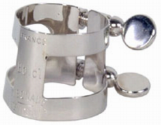
Most ligatures consist of thin metal bands which encircle a mouthpiece and reed, usually with thumb screws to allow the clamp to be tightened. While these things work well enough, they don't usually manage to keep the metal in even contact with the surface of the mouthpiece and reed they're holding together, as even thin metal isn't all that flexible. The alternative is a flexible ligature made of rubberized fabric.
The most commonly-found flexible ligatures are those made by Rovner. I use these on all my horns — they produce a much darker tone than conventional metal ligatures, and they don't require nearly as much fiddling to get them positioned correctly. They're also said to allow marginal reeds to be played, wherein they'd be suitable only as very small paint scrapers were they confronted with a metal ligature.
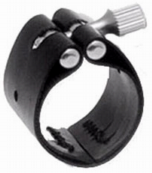
Most horns come with traditional metal ligatures — if you have a few bucks left over once you've finished paying for your sax, a Rovner ligature is well worth having.
There's one very small catch in using Rovner flexible ligatures — the brass fittings that hold the fabric band in place really do want to be greased before you use the ligature for the first time. Cork grease will suffice. Disassemble the ligature and grease the brass bolt that tightens the mechanism. Aside from extending the life of your ligature, the grease improves the transfer of vibration through the ligature, allowing it to produce a noticeably tighter sound.
SAXOPHONE CARE
A good saxophone can last for centuries if it's well looked after, or it can be a plant stand two years after it was purchased if it's neglected and abused. Neglected and abused saxophones occasionally turn up on Dateline to recount the lamentable tales of their last dark days, complete with hidden-camera video and testimonials from other brass instruments.
The principal components of a saxophone are brass — yes, it's metal, but it's relatively soft metal — and leather. Brass is easily dented, and leather can degrade with remarkable speed under the wrong conditions.
The most deleterious factor besetting most horns is moisture, followed closely by impact damage.
When you play a sax, a substantial amount of moisture will wind up in your horn. Of late, it has become politically correct to refer to this as "breath condensation," although we all know perfectly well that it's spit.
If you store your saxophone wet, the moisture will rot its leather pads and in extreme cases cause its brass to corrode. Both situations will require that you take your horn to a repair shop, and subsequently beat up your credit card pretty substantially to get it back.
You can mitigate the damage to your sax caused by moisture by removing as much of it as possible when you finish playing, and then arranging for whatever is left to evaporate harmlessly.
Cleaning your horn after you play it should never be optional.
When you finish playing, you should do the following:
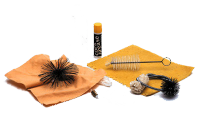
- Remove the neck from the body of the instrument, and remove the mouthpiece from the neck. Doing so in this order will prevent any force required to remove the mouthpiece from being inadvertently transmitted to the neck joint clamp, a relatively fragile mechanism.
- Pass a neck swab through the neck. This is usually a flexible metal rod or spring with something fuzzy attached to it to absorb moisture.
- Pass a cleaning swab through the body of your sax. This is usually a patch of silk or chamois leather with a brush or disk of foam behind it to keep it pressed against the inside of your horn, all tied to a string with a weight on the end. Lower the weight gently into the bell of your horn, followed by the patch. Turn your horn over so the weight travels down the body of your sax and emerges through the neck joint clamp. Pull the patch through your sax.
- Use a soft cloth to wipe down the exterior of the instrument to remove any spit — 'scuse me, "breath condensation" — that has escaped through the keys, and fingerprints and other contaminants that can degrade the lacquer.
When you're done cleaning your sax, you should clean the mouthpiece and reed:
- Remove the ligature.
- Wash the mouthpiece and reed in warm running water. Hot water or cleaners will degrade the surface of hard rubber mouthpieces and bring about the immediate demise of your reed. You'll probably find a line of something unnamable along the top surface of your mouthpiece, left by the edge of your lip. Rub this area with your thumb while you're washing the mouthpiece to prevent its accumulation.
- Push a mouthpiece brush through the mouthpiece. A mouthpiece brush looks like a very small neck swab.
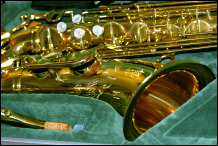
Saxophones usually come with cleaning swabs. More absorbent materials make more effective swabs. The most absorbent material on earth turns out to be silk, and the best cleaning swabs are made of this. Chamois leather is a close second. Some saxes come with cleaning swabs made of felt, flannel or cotton, none of which work all that well.
Considering what even the really good ones cost, you should consider buying a silk or chamois cleaning swab.
The most obvious place to store your saxophone will probably be in the case it arrived in. A sax case will shield its contents against falling objects and other projectiles, but once it's closed, it will trap any moisture your cleaning swab didn't remove. If your sax will be remaining in one place most of the time, you might consider an alternate strategy.
- If you have sufficient free table space, store your sax in its case but leave the top open. This will allow any moisture that evades cleaning to escape harmlessly.
- Alternately, consider storing your sax on a saxophone stand. Unlike a sax case, which will place some of the keys at the bottom of the instrument during storage — allowing moisture to pool therein — a saxophone stand will hold your sax vertically. It will also offer the best opportunity for moisture within the body of your horn to escape. The only catch in keeping your sax on a stand is that it will be somewhat exposed, and vulnerable to mishaps. I kept my horns on stands for some years until several close encounters with the tail of Morgan the incredibly huge Newfoundland dog convinced me that a case with its top up would probably be sufficient.
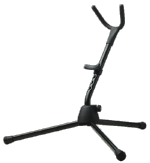
Whether or not you use it to store your horn, a sax stand is a worthwhile accessory. You're a lot less likely to dent your sax if you place it in a stand when the phone rings or your find yourself inexorably drawn to the fridge, rather than laying it down on a table or attempting to prop it up in a corner. Once again, these things aren't very expensive, and you should look for a reasonably good one. König & Meyer make excellent stands.
Should you have to store your saxophone in its case with the top down for extended periods, you might consider using a moisture absorber to keep residual dampness away from your horn. Large silica dessicant packets work well, although you'll have to change them each time you clean your horn. A lesser solution is to insert neck and body snakes into the neck and body of your horn respectively before you put it away. These are wire rods with fluff protruding from them — essentially full-length neck swabs — to draw moisture away from the inner surface of your sax.
Neck snakes are only effective if you arrange to dry them periodically. They'll do their best work if you have three or four of them, and rotate them each time you put your sax away.
As an aside, if you do store you sax in an open case or on a stand — such that a neck snake isn't really called for — a snake can still be useful. These things make excellent neck swabs. They'll scrub a lot more moisture from the inside of your saxophone's neck than a conventional swab. Using them in this way beats them up, however, requiring their periodic replacement.
I should note that much of the foregoing hardware is inapplicable to curved soprano saxophones — these horns are sufficiently unusual to have escaped the notice of the manufacturers of saxophone accessories. I've yet to find body or neck swabs for a curved soprano sax, nor do any commercial stands seem to suit them. Should you find yourself with such an instrument, you can use a recorder swab to clean its neck, a bass recorder swab to clean its body and a conventional alto sax stand to hold it if you bend the prongs of its fork to the diameter of the bell of your horn. In this application, I wouldn't recommend a König & Meyer stand, which are built of really good steel that resists bending. An economical metal stand and a pair of vice-grips are called for.
Protecting your saxophone from dents and abrasions is almost as important as keeping it dry. Dents will affect the sound of your horn if they're severe or numerous enough, and they're expensive to have repaired. Damage to a saxophone's lacquer will permit its brass to tarnish and in extreme cases, to corrode.
Most of the things you can do to protect your horn from dents are fairly obvious:
- Avoid playing near large, rapidly moving objects, such as bass players.
- Avoid moving your horn rapidly if you're next to something large, hard and unlikely to get out of the way — again, a bass player, for example.
- Support your sax with a neck strap. A good neck strap will attach to your saxophone with a dog clip, rather than an open hook. Strong plastic clips are preferable to steel ones, as the latter may scratch your horn. In the absence of a genuine saxophone strap, a camera strap can be a workable substitute.
- Don't sit in a chair with hard metal arms when you play your saxophone.
- Don't let your sax dangle by its neck strap.
- Your saxophone should always be in one of three places — in your hands, on its stand or in its case. Don't put it down or lean it in a corner.
You should also be careful how you handle your sax when you're removing it from or returning it to its case. Hold it by its bell, not by its keys.
Your sax should have come with a plastic plug that fits in its neck clamp, in place of the neck itself. These things look like they're probably just in there to ship your horn — don't discard this plug. It's real purpose is to keep the end of your sax from striking the top of its case and damaging the pin that operates the octave key on its neck.
You should install a neck plug in your sax if you'll be moving it. If you store it on a stand or in its case with the top open — such that it's clearly not going anywhere — leave the neck plug out.
Don't attempt to clean your sax with abrasive cleaners, brass polish, sandpaper, steel wool or caustic cleaners. Keep in mind that the surface of your instrument is lacquer, not brass. Cleaning techniques that make brass coffee pots shine will nuke the finish of your horn.
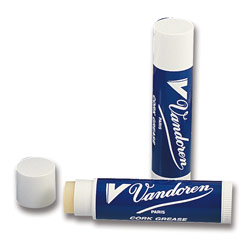
The end of the neck of a saxophone is covered with a sheet of cork to grip its mouthpiece. If you're careful with the neck cork of your horn, it will last for ages. It's relatively easy to beat up the cork covering, however, and they're expensive to have replaced.
Prior to installing the mouthpiece of your saxophone, it's extremely important to grease the neck cork with saxophone cork grease. Cork grease comes in exceedingly civilized plastic tubes, similar to the ones lip balm is sold in, such that you won't have to get the stuff on your fingers to apply it. You should buy several of these and leave one as a spare in your sax case, such that you won't run out of it and be tempted to play your horn without it.
It's a good idea to grease the neck cork of your sax every time you play it. I do so when I'm disassembling my horns after I play them, as I rarely think of it when I'm about to play. Aside from allowing your mouthpiece to slide easily onto your sax's neck, cork grease also helps displace moisture that might otherwise deteriorate the cork.
In some cases, new saxophones — or saxes which have been rebuilt with new neck corks — will exhibit minor size issues. Not all mouthpieces have precisely the same inner diameters. If your mouthpiece is slightly too loose, cork grease will usually take up the slack. If it's too tight, you'll probably have to fight with it every time you install and remove it, which can damage your saxophone's neck. In this case, the very careful application of some fine sandpaper can reduce the effective thickness of your neck cork by a few thousandths of an inch until your mouthpiece fits without a struggle.
If you find your neck cork is substantially smaller than the internal diameter of your mouthpiece, you should have the neck cork replaced. Failing this, you can cheat by wrapping your neck cork with Teflon plumber's tape. Make sure you apply an even layer of tape for the entire length of the cork, building up the diameter until your mouthpiece slides into place with moderate effort. This has the side benefit of eliminating the need for cork grease, as Teflon is naturally slippery. Be warned, however — any moisture present in your neck cork when you tape it will stay there. It's a good idea to leave your saxophone's neck somewhere dry for a day or so, and avoid playing it, before you tape it.
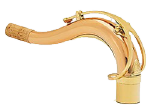
Teflon plumber's tape does not use adhesive to keep it in place, and Teflon is chemically inert, so it won't react with your neck cork. Do not substitute other kinds of tape — wrapping your neck cork with duct tape will just make it look cheesy.
The neck clamps of most saxophones permit their necks to be installed without much resistance. If your horn has a particularly tight neck clamp, you might have to grease it as well. Cork grease doesn't work well in this case. The ideal lubricant for a saxophone neck clamp is trumpet slide grease — sadly, it isn't sold in plastic tubes, and you will have to get your hands slippery to apply it. Make sure you wipe both the neck joint and the internal surface of the clamp with a Kleenex or a soft cloth to remove any particles of brass before you lubricate it.
Remove any cork grease or neck clamp lubrication from the lacquer surfaces of your horn with a soft cloth as quickly as possible.
LEAKS
The most common playing issue for saxophones — ignoring misbehaving reeds and death threats from the neighbors — is air leaks. These can be frustrating, as they often seem to be something else.
A saxophone is fingered the same way for both octaves. You can make a sax play in its upper octave by depressing its octave key. The octave key opens small valves on the neck and upper body of a sax which lets some air escape, and persuades its reed to vibrate at a higher pitch. It's effectively a set of controlled leaks.
When one of the keys of a saxophone develops an un-planned for leak, it usually has much the same effect as the octave key — but not, as a rule, when you want to change octaves. A sax with a leak will often refuse to play some notes in the low octave, or play them in the high octave with no regard for the octave key, or play them as a combination of the high and low octave, or warble gracelessly between the two. It's easy for beginning sax players to assume that these bad notes are the result of their as yet imperfect playing abilities, when they're really caused by mechanical problems.
Leaks have a number of possible causes:
- Cracked, worn or rotted pads: This requires the attention of a saxophone repair person. You can usually spot these yourself — look for a clean circle where each tone hole meets its pad. A flashlight is helpful in checking them out. An obvious break in the circle indicates a potential leak.
- Damaged or corroded tone holes: If the metal ring that makes contact with a pad isn't clean and flat, air will leak between it and the leather. Dirt or corrosion can be removed with a Q-Tip and some alcohol. Actual damage to the metal calls for professional assistance.
- Misadjusted arms, rods or other mechanical elements: Several of the keys of a saxophone are operated by complex mechanical linkages which have to be properly adjusted to close. Over time they can wear or creep out of alignment. Fixing them often entails nothing more than turning a screw, but knowing which screw to turn is a larger issue.
In trying to determine the cause of a leak, keep in mind that the key that's leaking will be somewhere above the one that doesn't play correctly.
The fundamental weapon of intrepid leak hunters is a leak light. Nowhere near as disreputable as it sounds, a leak light is usually a narrow fluorescent tube that can be lowered into your saxophone. Having illuminated the interior of your horn, close each key and check for light visible between the pad and the top of the tone hole it rests on. If light can escape, so can air.
This is, for the most part, how serious saxophone repair technicians identify leaks as well. While you might not be qualified to fix a leaking saxophone, the application of a leak light will determine whether those weird notes your sax has been responsible for of late can be blamed on a genuine mechanical problem, or just questionable lip action. It's worth having a leak light for this reason — it will help you decide when to call in the big guns, and bring your instrument to a repair shop.
Commercial leak lights cost the better part of a hundred dollars. Alternately, if you're not likely to cause yourself serious physical injury with hand tools and a soldering iron, you can mutate a battery-powered fluorescent hand light into one. If you do so, you should keep the following in mind:
- Make sure you buy a flashlight with a sufficiently narrow tube to fit into your sax without getting stuck. Fluorescent automotive work lights are usually not suitable unless you play one of the contrabass saxes discussed earlier.
- A battery-powered flashlight is preferable to a light that plugs in, even if you can find the latter with a small enough tube — batteries are less likely to zap you if something goes wrong.
- The little circuit board stashed inside such a flashlight drives a transformer — twelve volts in, about a hundred volts out. Avoid messing with the wiring when the light is on.
- Once you've finished modifying your flashlight, it's a really good idea to wrap the fluorescent tube in several layers of clear box tape, such that if it goes to pieces whilst inside your sax, you won't be confronted with the prospect of recovering billions of tiny fragments of glass.
Absent a serious leak light, a small MagLite and a length of string can be a reasonable source of illumination for stalking leaks.
PLAYING YOUR SAXOPHONE
Check the page slider for your web browser. There's almost nothing left of this article. After all that preamble about buying a sax, choosing reeds, cleaning your instrument and such, it has very little say about actually playing the beast. You really have to wonder about its priorities.
The awful truth is this — no one other than yourself can teach you to play an instrument. This may seem like a questionable prospect, in that were it true, the party who will be teaching you to play sax doesn't currently know how to do so. It's all very Zen-like.
Almost everything involved in actually learning to play sax is understanding how to work the instrument, developing the muscles and neural pathways to work its reed and keys, and then practicing your brains out. For the most part, these are things you'll have to do by yourself.
This is not to say that a professional music teacher might not make the task easier. If you need some structure imposed on an undertaking this daunting, a teacher could well be of considerable assistance. A music teacher will explain the rudiments of the instrument, provide you with some tunes to play, evaluate your progress on a weekly basis and assign you more challenging pieces as you need them. This is not the same as unscrewing the top of your head and pouring sax-playing ability into your brain.
If you have a reasonable degree of self-motivation, you can arrive at much the same results with a fingering chart, a basic introduction to your instrument — there are numerous good beginner sax guides available — and a serious practice schedule.
While hardly exhaustive, the following are some useful bits to keep in mind about learning to play your horn.
Practice daily: In the century and a half since its creation, no saxophone has ever been mastered while it was locked in its case. Pick up your horn and play it at least once a day, even if you can only squeeze in ten or twenty minutes of practice.
Work those lips: If you've never played a saxophone — or a similar instrument, such as a clarinet — you're physically incapable of playing one right at the moment. Working the reed of a saxophone requires serious lip muscles to properly compress the reed. You'll need to be able to surround the reed and mouthpiece with a ring of muscle. Just like the other muscles in your body, you'll need to develop your lip muscles before they'll be up for the work. Your sax is going to sound like an industrial accident for the first few weeks as your lip muscles get up to speed. Deal with it. The more you practice, the sooner the other members of your family will stop throwing things.
This is also true of your fingers, albeit for different reasons. If you perform an identical motor action repeatedly — such as operating the keys of a saxophone — your brain will form neural pathways to make the action in question easier, quicker and more intuitive. Think of them as shortcuts between your brain and your fingers for frequently used tasks. As you practice, the neural pathways that will make playing your easier will develop and become more accessible.
Practice alone at first: Allowing that your saxophone isn't going to impress anyone for the first few weeks of its time with you, find a practice room where you're unlikely to be overheard — well, at least where you're unlikely to cause anyone nearby permanent hearing loss — and close the door behind you. You'll feel a lot less self-conscious about playing if you're not in the faces of everyone else in the house.
Practice during the day when you can: All other things being equal, your cognitive abilities and the strength of your lips will deteriorate as the evening wears on. You'll have a harder time playing if you do so at the end of the day, when you're running on empty. In that it's a lot more encouraging to play well, especially as you're getting into playing a new instrument, do it when you're at your best. Alcohol, cigarettes and caffeinated drinks will also deteriorate your ability to play your horn.
Choose music you actually want to play: Introductory saxophones books often include example pieces that one can only assume the author of the book liked. You probably won't. Choose some practice tunes that you'll enjoy playing. Don't be concerned if they don't seem like they were written specifically for the saxophone — very little is.
Learn from other sax players: Listen to recordings with sax parts, and listen specifically for the saxophone. When you've improved your playing to the point of being able to play when you hear, teach yourself to play some of the sax parts you've heard on CDs.
Watch TV: If you watch television alone — or with someone who's unspeakably obliging — leave your sax assembled and on a stand. Pick it up during commercials and practice. It will save the mute button on your remote for loftier things, and you'll get a fair bit of practice in. An hour of broadcast television typically includes almost twenty minutes of commercials for things no one really wants.
Learn to sight-read: You really do need to read music, and it's not all that difficult to master with sax. Doing so will give you access to lots of tunes to practice. There are twelve notes in an octave... how hard can it be?
Go stand in a corner: As with most instruments, a saxophone is designed to project sound toward whoever's listening to it — or whoever just happens to get in the way. You can enjoy a better appreciation of your level of ability if you arrange to be able to hear your sax as someone sitting in front of it would. Yes, perhaps "enjoy" wasn't the most appropriate word in this case. Face a hard brick or plaster wall when you play to bounce the sound back to your ears. A corner is even better.
Practicing your sax can be acoustically interesting and artistically challenging, but it will probably be visually dull. A nearby window with a view is desirable. Lacking one, if you can spare a few more bucks after you've paid for all this stuff, consider augmenting the wall or corner you usually face with a light effect that reacts to sound. Luminglas disks and plasma spheres are ideal for this application. They'll give your eyes something to look at, as they react to ambient sounds.
LEFTOVER BITS AT THE END
Some of the manufacturers mentioned in this article were:
- Flavoreed: www.flavoreeds.com
- Keilwerth: www.schreiber-keilwerth.com/
- König & Meyer: http://www.k-m.de
- Korg: www.korg.com
- L.A. Sax: www.lasax.com
- Rico: www.ricoreeds.com
- Rovner: www.rovnerproducts.com
- Selmer: www.selmer.com
- Vandoren: www.vandoren.com
- Yamaha: www.yamaha.com
- Yanagisawa: www.yanagisawasax.co.jp
I bought most of my contemporary saxophones — and almost all the attendant accessories thereof — from www.harknettmusic.com. Ask for Jon.
My Keilwerth Shadow alto horn came from Musician's Friend.
My Conn C melody sax was expertly restored to a miraculous state by USA Horn, from whence it was bought.
My Selmer Series III alto hails from Woodwind and Brasswind.
All the lists of things at this page which involve manufacturers' products have been assembled in alphabetical order — the relative placement of the items therein does not reflect my preferences.
The photograph of a saxophone in the link graphic from the Articles page is by Carin Araujo, used under license from freeimages.com.
|
PLEASE DON'T COPY THIS PAGE
The contents of this page are copyright © 2003 — 2025 Alchemy Mindworks. Some portions are copyright © 2003 — 2025 Steven William Rimmer. The copyright holders specifically prohibit reproduction, transmission, duplication or storage of this page or any portion thereof in any electronic or physical medium, under any circumstances. Reproducing all or part of this page against our express wishes may result in severe civil and criminal penalties. The lawyers made us say that.
Please contact us for reproduction rates if you'd like to reproduce all or part of this page on paper. If you like this page and wish to share it, you are welcome to link to it, with our thanks.
|

